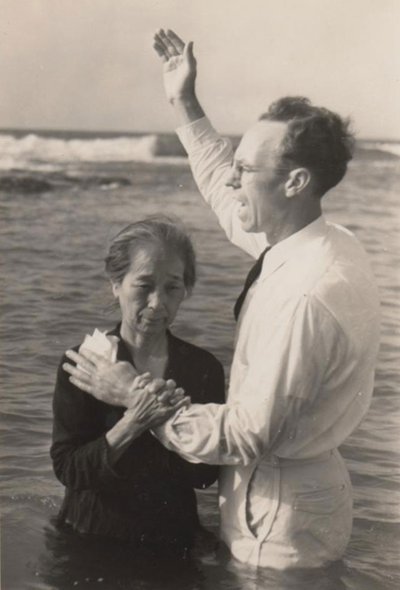
Missionary built first Adventist church, hospital on island ravaged by WWII
Ejler Jensen was the first Seventh-day Adventist missionary to the
Japanese island of Okinawa, where he planted a vibrant church community,
including a school and hospital, in the 1950s.
Jensen, who died at age
102 on August 27, set about building an Adventist church big enough for 200
people on Okinawa when there was 600,000 people and not one single Adventist on
the island, which was devastated after World War II. Building materials
consisted of war remnants and military supplies. The church opened in
1951.
He later opened a school in the southern part of the island, and
then a church attached to the school. As church membership increased, Jensen
began designing a 15-bed hospital that is regarded today as the leading private
hospital on the island.
Thirty-nine patients showed up on opening day of
the clinic, which was located up a steep hillside. “Within a year, the lone
doctor was seeing over 200 patients a day,” his daughter Linda said. The
facility, the Adobenchisuto (Adventist) Medical Center, moved to a new location
with more than 100 beds a few years ago.
"Adventist members in Okinawa
and the Japan Union Conference will never forget Elder Jensen, who built the
foundation of the Okinawa Mission,” said Masumi Shimada, president of the
denomination’s Japan Union Conference. “We appreciate his efforts and love for
Okinawa and remember his service to the Lord.”
Ejler E. Jensen was born
in 1912 to Danish immigrants in Alberta, Canada. The Lutheran family converted
to the Adventist Church through an Adventist bookseller.
As a young
child, Jensen became fascinated with mission stories told at campmeetings at
Canadian Junior College (now Canadian Union University).
The family moved
to Modesto, California, United States, in 1918 to grow table grapes, but a
combination of drought, gophers, and a weak economy devastated them. Financially
ruined, they moved back to Canada.
Attempts to farm wheat proved
successful until the Dust Bowl and Great Depression hit in 1929 and 1930. The
howling winds blew crops and soil away. The family lost everything and had to
walk away, destitute and in debt.
At age 20, Jensen became a literature
evangelist to raise money for college. He was given an old bicycle with wooden
wheels and a territory of hundreds of miles. He later described this time as the
most lonely of his life, going from house to house in the country, seeing
strange faces every day and asking for a bed to sleep on.
Jensen
attended Canadian Junior College from 1936 to 1939 and then transferred to
California-based Pacific Union College, where he graduated in 1942 with a double
major in Bible and history. At PUC, he met Iona Clark, and the couple married in
1942.
After serving as a pastor for two years in the U.S. states of
Nevada and Utah, Jensen accepted a call in 1944 to work as head of the Alaska
Mission, a territory that would later become a U.S. state.
At times it
took days to reach remote parts of the territory, with Jensen catching rides on
fishing boats, Coast Guard lifeboats and with bush pilots delivering supplies
and mail with amphibious aircraft.
One night, while flying with a bush
pilot, a storm forced a landing on a small, isolated inlet. Ice developed on the
wings and propeller and the plane began to sink.
Jensen and the pilot
jumped out and waded to shore. Disoriented, wet, and freezing, Jensen began to
pray fervently. Then, out of the blowing snow, an old Eskimo appeared, dressed
in white, and waved at the lost pair to follow him. He led them through the
storm to a small settlement, where villagers gave them shelter until the storm
passed.
When Jensen asked the villagers for the rescuer’s name in order
to thank him, the villagers replied that no such person lived in the
area.
“Dad was certain that his guardian angel had appeared to save him
that day,” Linda said.
While in Alaska, Jensen accepted an invitation to
serve as a missionary in Indonesia. Seventeen days into the voyage across the
Pacific Ocean aboard a freighter he received a cable asking him to go to Japan
instead.
The couple enrolled in a language school and spent the next year
and a half becoming fluent in Japanese. In 1949, local Adventist leaders decided
to open mission work on Okinawa, and the Jensens agreed to move there.
In
1960, after a decade on Okinawa, Jensen was appointed as the head of the Tokyo
Sanitarium and Hospital (now Tokyo Adventist Hospital) and the pastor of a
church on the same property. Six years later he moved to Malaysia, where he
worked as business manager of the Penang Sanitarium (now Penang Adventist
Hospital) as well as the pastor of the English-speaking church with a membership
of 200.
With both daughters in college, he and his wife decided to return
to the U.S. in 1969.
He worked for four years as an assistant credit
manager at St. Helena Hospital in Deer Park, California, and then pastored a
church in Miranda, California.
The couple retired in 1975 in California’s
Napa Valley. Iona preceded him in death in 2005.
Today, Okinawa has 16
Adventist churches with a membership of nearly 2,100, according to the Adventist
Yearbook.
Andrew McChesney